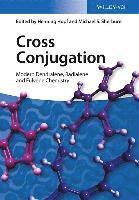
- Format
- Inbunden (Hardback)
- Språk
- Engelska
- Antal sidor
- 480
- Utgivningsdatum
- 2016-04-20
- Förlag
- Blackwell Verlag GmbH
- Medarbetare
- Hopf, Henning (ed.), Sherburn, M. S. (ed.)
- Illustratör/Fotograf
- 400 schwarz-weiße und 20 farbige Abbildungen
- Illustrationer
- 400 schwarz-weiße und 20 farbige Abbildungen
- Dimensioner
- 249 x 173 x 23 mm
- Vikt
- Antal komponenter
- 1
- ISBN
- 9783527334377
- 1044 g
Cross Conjugation
Modern Dendralene, Radialene and Fulvene Chemistry
Kundrecensioner
Fler böcker av författarna
-
Classics in Hydrocarbon Chemistry
Henning Hopf, Henning Hopf, Hopf
-
Wie funktionieren organische Reaktionen?
Peter Sykes, Peter Sykes, Henning Hopf
-
Modern Cyclophane Chemistry
Henning Hopf, Rolf Gleiter, Henning Hopf, Rolf Gleiter, Henning Hopf
Övrig information
Born in 1940, Henning Hopf was Director of the Institute for Organic Chemistry at the TU Braunschweig. After studying chemistry in Gottingen and at the University of Wisconsin in Madison, where he gained his doctorate 1967, he qualified as a professor in 1972 at the University of Karlsruhe. Three years later he was offered a position at the University of Wurzburg and from there followed an offer of a professorship at Braunschweig in 1979 from which he retired in 2006. His main areas of research concern hydrocarbon chemistry (alkynes, allenes, cumulenes, aromatic compounds, cyclophanes, polyolefines, etc.) and mechanistic investigations of high-temperature reactions. For his scientific oeuvre he is received many national and international awards. He served as the President of the German Chemical Society (GDCh) whose Honorary Member he is. Born in 1966, Michael Sherburn is Professor of Chemistry at the Research School of Chemistry at the Australian National University in Canberra, Australia. He studied chemistry first at The University of Nottingham, from where he obtained his PhD degree in 1991, then as a postdoctoral fellow at the Australian National University. He held positions at Massey University in New Zealand and The University of Sydney before returning to the Research School of Chemistry in 2002. His research interests focus on the development of efficient synthetic methods, strategies and tactics for the synthesis of natural and unnatural structures.
Innehållsförteckning
List of Contributors XI Preface XV 1 Synthesis of Dendralenes 1 Nicholas J. Green,Mehmet F. Saglam, andMichael S. Sherburn 1.1 Introduction 1 1.2 Multibond Forming Processes 2 1.2.1 Double Alkenylation Reactions 2 1.2.2 Double Alkenation Reactions 4 1.2.3 Other Multibond Forming Processes 10 1.3 Solo-Bond-Forming Reactions 15 1.3.1 C1C2 Alkenation Reactions 15 1.3.2 C2C3 Alkenylation Reactions 17 1.3.3 C3C3 Alkenation Reactions 25 1.4 Dendralenes from Dendralenes 28 1.5 Functional Group Interconversion Reactions 31 1.6 Concluding Remarks 32 References 32 2 The Diene-Transmissive Hetero-DielsAlder Reaction 39 Takao Saito and Noriki Kutsumura 2.1 Introduction 39 2.2 DTHDA Reaction of Heterotrienes 41 2.2.1 DTHDA Reaction of Thiatrienes 41 2.2.2 DTHDA Reaction of Oxatrienes 42 2.2.3 DTHDA Reaction of Azatrienes 46 2.2.4 DTHDA Reaction of Dioxatrienes as Masked Oxathiatrienes and Oxazatrienes 51 2.3 DTHDA Reaction with Heterodienophiles 52 References 56 3 The Nazarov Cyclization of Cross-Conjugated Ketones 59 Louis Barriault and Mathieu Morin 3.1 Introduction 59 3.2 Mechanism 59 3.3 Substituent Effects 60 3.3.1 -Substituents 60 3.3.1.1 Steric Hindrance 60 3.3.1.2 Electron-Donating Substituents 61 3.3.1.3 Electron-Withdrawing Substituents 62 3.3.2 -Substituents 63 3.3.2.1 Steric Hindrance 63 3.3.2.2 Electron-Donating Substituents 65 3.3.3 Torquoselectivity 65 3.3.3.1 Silyl Groups as Traceless Substituents 66 3.3.3.2 Allenyl Alkenyl Ketones 67 3.3.3.3 Chirality Transfer 68 3.3.3.4 Catalysis of the Nazarov Reaction 69 3.4 Interrupted Nazarov Reactions 73 3.4.1 Cascade Cyclizations 73 3.4.2 [3+2]- and [4+3]Cycloadditions of the Oxyallyl Cation 74 3.4.3 Intermolecular Trapping of the Nazarov Intermediate 75 References 78 4 [n]Radialenes 79 Gerhard Maas 4.1 Introduction 79 4.2 Syntheses and Reactivity 80 4.2.1 [3]Radialenes 81 4.2.2 [4]Radialenes 89 4.2.3 [5]Radialenes 97 4.2.4 [6]Radialenes 98 4.2.5 Higher [n]Radialenes and Radialene Substructures in Polycyclic Conjugated -Systems 105 4.3 Structural and Bonding Properties 107 References 111 5 Oxocarbons, Pseudo-oxocarbons, and Squaraines 117 Vanessa E. de Oliveira, Renata Diniz, Flvia C. Machado, and Luiz Fernando C. de Oliveira 5.1 Introduction 117 5.2 Oxocarbons and Coordination Chemistry 121 5.3 Pseudo-oxocarbons 128 5.3.1 Squaraines 132 5.4 Conclusion and Outlook 139 References 139 6 Recent Developments in Fulvene and Heterofulvene Chemistry 145 Takeshi Kawase and Hiroyuki Kurata 6.1 Introduction 145 6.2 Triafulvenes 148 6.2.1 Benzotriafulvene and Related Compounds 149 6.2.1.1 Synthesis 149 6.2.1.2 Reactions of Benzotriafulvenes 149 6.2.2 Triafulvalene and Related Compounds 150 6.2.2.1 Synthesis of Benzotriafulvalenes 150 6.2.2.2 Triafulvalenes 151 6.2.2.3 Cyclic Bicalicenes 151 6.2.3 Heterotriafulvenes 152 6.2.3.1 Cyclopropenones (CPNs) 152 6.2.3.2 Reaction of CPNs and Related Compounds 154 6.2.3.3 Cyclopropenone Imides (Azatriafulvenes) 159 6.2.3.4 The Other Heterotriafulvenes 159 6.3 Pentafulvenes and Related Compounds 162 6.3.1 Pentafulvenes 162 6.3.1.1 Synthesis of Pentafulvenes 162 6.3.1.2 Reactions of Pentafulvenes 175 6.3.2 Pentafulvalenes 179 6.3.2.1 Synthesis of Symmetric Benzofulvalenes 179 6.3.2.2 Synthesis of Asymmetric Benzofulvalenes 182 6.3.3 Synthesis of Pentafulvenes as Functional Dyes 183 6.3.3.1 6,6-Dicyanofulvenes 183 6.3.3.2 1,3-Dithiafulvalenes 186 6.3.4 Fused Ring Systems Involving Pentafulvene Moieties 187 6.3.4.1 Dibenzopentalenes 191 6.3.4.2 Indacenes 196 6.3.4.3 Heterocyclic Systems 198 6.3.4.4 Carbaporphyrinoids 201 6.3.4.5 Reactions of Fulvalenes for the Construction of Fullerene Fragments 202 6.3.5 Cyclopentadienones (Oxapentafulvene) 205 6.3.5.1 Synthesis of CPDN 207 6.3.5.2 Reaction of CPDNs 219 6.3.6 Heterofulvenes 222 6.3.6.1 Azaful
Du kanske gillar
-
Empire of AI
Karen Hao
Inbunden -
Orbital
Samantha Harvey
Häftad
